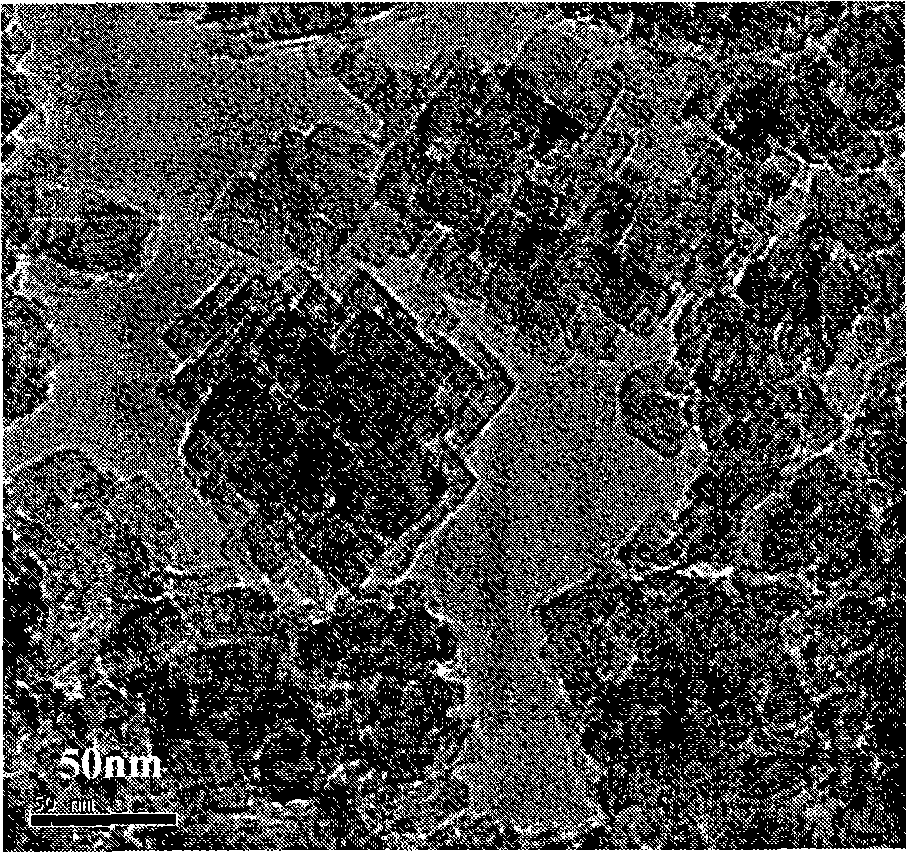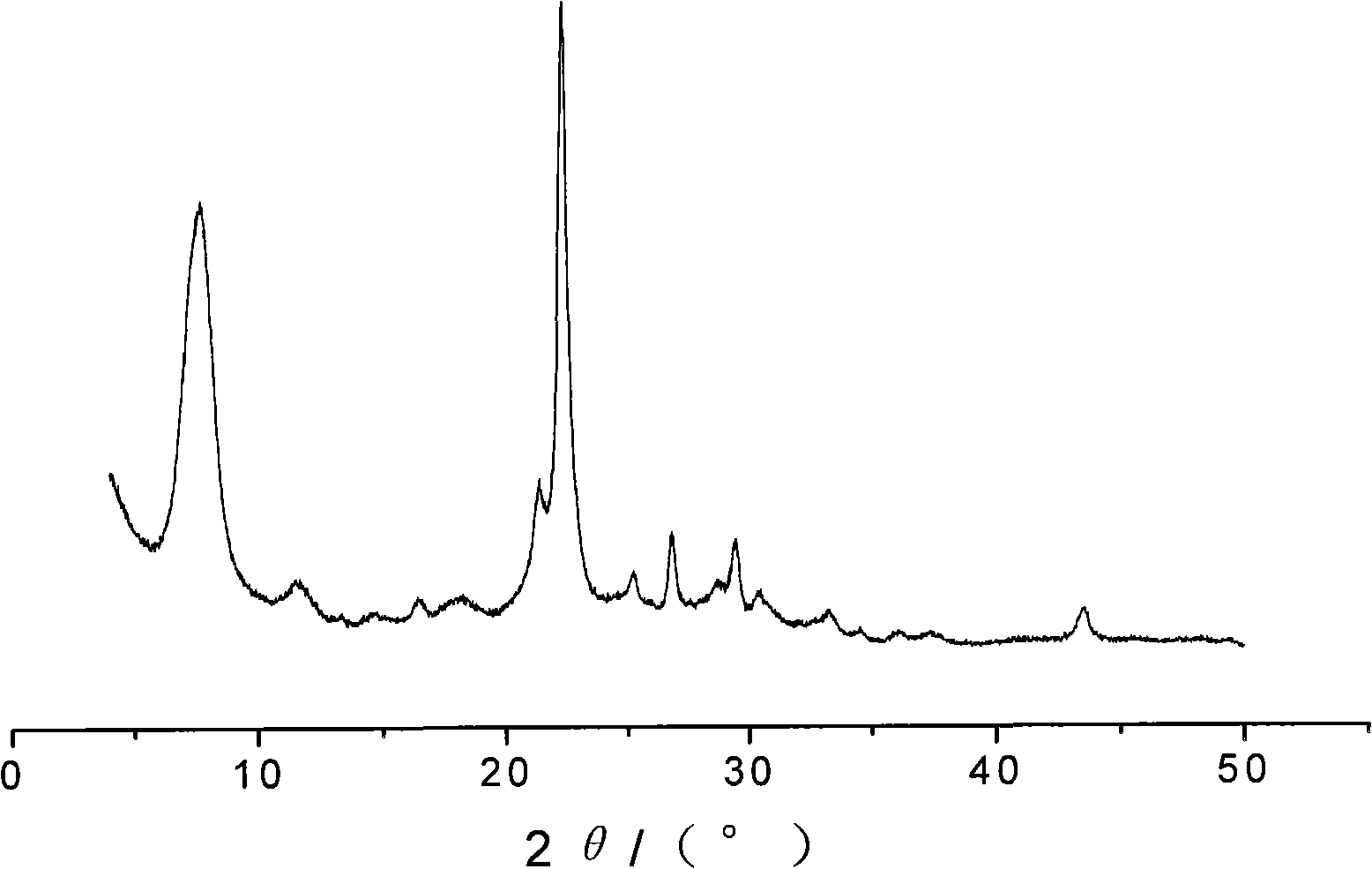Synthetic method of nano aluminum-rich beta-zeolite
A beta zeolite, aluminum-rich technology, applied in the field of synthesis of aluminum-rich beta zeolite, can solve the problems of low yield and crystallinity, long crystallization time, etc., and achieve low water content, less lattice defects, and good diffusion performance Effect
- Summary
- Abstract
- Description
- Claims
- Application Information
AI Technical Summary
Problems solved by technology
Method used
Image
Examples
Embodiment 1
[0037] (1) Mix 3.0g pseudo-boehmite (31.8% by weight on ignition) with 20.0g water to make a slurry and disperse evenly, then add HCl dropwise to carry out acidification to form a sol, wherein HCl: Al 2 o 3 =0.25 (molar ratio), add 80~120 order 6.8g fine-pore chromatographic silica gels (burning minus 10.0% by weight) wherein, and ultrasonic dispersion is uniformly mixed, wherein: SiO 2 / Al 2 o 3 The molar ratio is 5; after drying at 120°C, it is crushed into 40-200 mesh silica-alumina colloidal particles.
[0038] (2) Add template agent TEAF to the silica-alumina colloid particles obtained in step (1) to mix and crystallize, and the silica-alumina colloid particles (using SiO 2 meter), template agent tetraethylammonium fluoride TEAF and water according to SiO 2 : TEAF: water = 1:0.05:2.0 molar ratio, mixed evenly, then placed in a rotary oven, dynamically crystallized at 80°C for 48 hours, then dynamically crystallized at 140°C for 48 hours, and then taken out Sample 2 w...
Embodiment 2
[0041] (1) Mix 3.1g of alumina trihydrate and 63g of water to make a slurry and disperse evenly, acidify with acetic acid to form a sol, in which acetic acid and Al 2 o 3 The molar ratio is 0.35, then add 10.3g of white carbon black particles of 80~120 meshes (6.8% by weight) to it, and ultrasonically disperse and mix evenly, wherein: SiO 2 / Al 2 o 3 The molar ratio is 8; then, after drying at 120°C, it is crushed into 40-200 mesh silica-alumina colloidal particles.
[0042] (2) Add templating agent, TEAOH, HF, and water to the silica-alumina colloid particles obtained in step (1) and mix and crystallize evenly, wherein the molar ratio of each raw material is as follows: TEA + / SiO 2 =0.08, F - / TEA + = 1.5, H 2 O / SiO 2 =4.5, then placed in a rotary oven, dynamically crystallized under the condition of 100°C for 24 hours, then dynamically crystallized under the condition of 170°C for 48 hours, then took out suction filtration, washed, dried, and roasted to obtain sampl...
Embodiment 3
[0045] (1) According to ethyl silicate (as SiO 2 ) : ammonium fluoride: water = 1.0: 0.015: 4.0 molar ratio, add ammonium fluoride and ethyl silicate successively into the water and mix thoroughly, when the pH is 6-8, and the temperature is 25-40 ℃ , aged for 24 hours to obtain silica gel, dried the obtained silica gel at 120°C for 48 hours, and ground into silica gel particles of 40-200 mesh.
[0046] Mix 6.1g of aluminum hydroxide with 45.1g of water, beating and dispersing evenly, acidify with formic acid to form aluminum sol, wherein formic acid and Al 2 o 3 The molar ratio is 0.55. 13.9g of silica gel particles (13.8% by weight) were added into the aluminum sol and ultrasonically dispersed and uniformly mixed, wherein: SiO 2 / Al 2 o 3 The molar ratio is 10; then, after drying at a temperature of 120°C, it is crushed into 40-200 mesh silica-alumina colloidal particles.
[0047] (2) the silica-alumina colloid particles obtained in step (1) are mixed with TEABr, NH 4 ...
PUM
| Property | Measurement | Unit |
|---|---|---|
| particle size | aaaaa | aaaaa |
Abstract
Description
Claims
Application Information
 Login to View More
Login to View More - R&D
- Intellectual Property
- Life Sciences
- Materials
- Tech Scout
- Unparalleled Data Quality
- Higher Quality Content
- 60% Fewer Hallucinations
Browse by: Latest US Patents, China's latest patents, Technical Efficacy Thesaurus, Application Domain, Technology Topic, Popular Technical Reports.
© 2025 PatSnap. All rights reserved.Legal|Privacy policy|Modern Slavery Act Transparency Statement|Sitemap|About US| Contact US: help@patsnap.com


